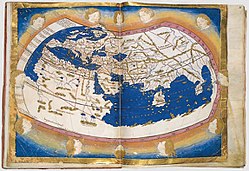Old World: Difference between revisions
Appearance
Content deleted Content added
back to sounder version |
No edit summary |
||
| Line 2: | Line 2: | ||
[[File:Ptolemy World Map.jpg|thumb|250px|Map of the "Old World" (the [[Ptolemy world map]] in a 15th century copy)]] |
[[File:Ptolemy World Map.jpg|thumb|250px|Map of the "Old World" (the [[Ptolemy world map]] in a 15th century copy)]] |
||
The '''Old World''' consists of those parts of [[World map|the world]] known to [[classical antiquity]] and the European [[Middle Ages]]. It is used in the context of, and contrast with, the "[[New World]]" (i.e., the |
The '''Old World''' consists of those parts of [[World map|the world]] known to [[classical antiquity]] and the European [[Middle Ages]]. It is used in the context of, and contrast with, the "[[New World]]" (i.e., the Americas). |
||
The ''Old World'' comprises [[Africa]], [[Asia]], and [[Europe]] (collectively known as [[Afro-Eurasia]]), plus surrounding islands (or at least those parts which were known to classical geography before the 15th century). |
The ''Old World'' comprises [[Africa]], [[Asia]], and [[Europe]] (collectively known as [[Afro-Eurasia]]), plus surrounding islands (or at least those parts which were known to classical geography before the 15th century). |
||
Revision as of 20:52, 2 January 2012

The Old World consists of those parts of the world known to classical antiquity and the European Middle Ages. It is used in the context of, and contrast with, the "New World" (i.e., the Americas).
The Old World comprises Africa, Asia, and Europe (collectively known as Afro-Eurasia), plus surrounding islands (or at least those parts which were known to classical geography before the 15th century).
The concept of the three continents in the Old World goes back to classical antiquity. Their boundaries as defined by Ptolemy and other geographers of antiquity were drawn along the Nile and Don rivers. This definition remained influential throughout the Middle Ages (see T and O map) and the Early Modern period.
See also
- Afro-Eurasia
- Age of Exploration
- Eastern Hemisphere
- Far East
- New World
- Synoptic table of the principal old world prehistoric cultures











